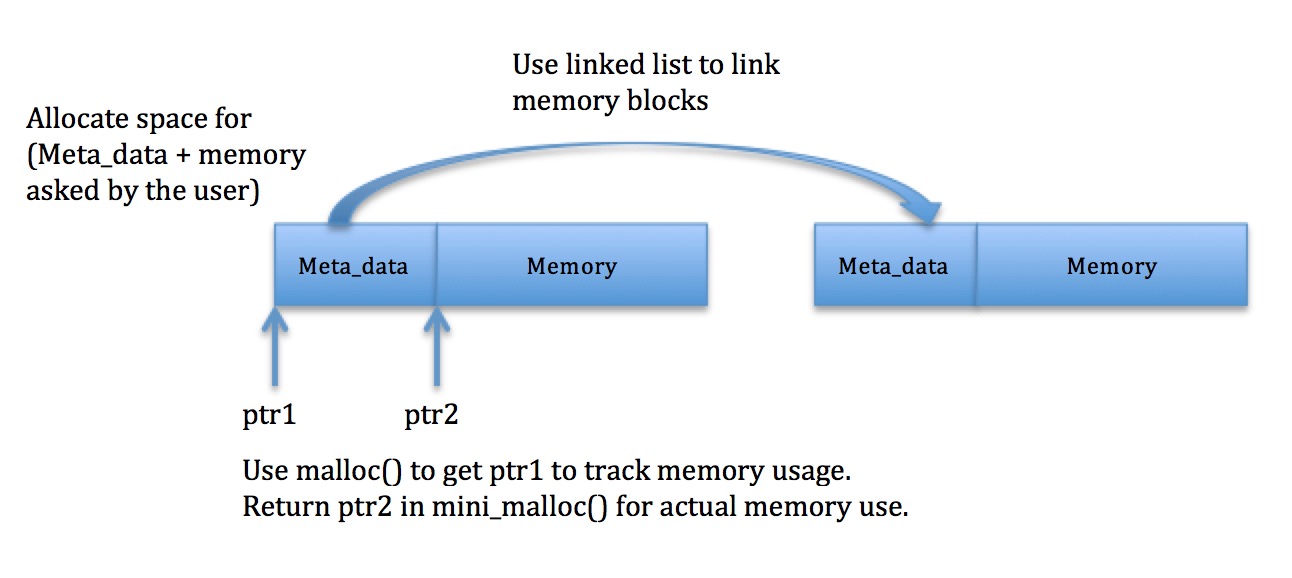Mini Valgrind Edit on Github
Learning Objectives
The learning objectives for Mini Valgrind are:
- Using metadata for memory bookkeeping
- Memory management and linked lists
- Learning what Valgrind does
- Preparation for the Malloc MP
Suggested Readings
We suggest you read the following from the
wikibook
before starting Mini Valgrind:
- Memory, Part 1: Heap Memory Introduction
- Memory, Part 2: Implementing a Memory Allocator
- Memory, Part 3: Smashing the Stack Example
Overview
For this lab, you will be implementing a small version of Valgrind called mini_valgrind. Valgrind is a great tool for monitoring memory usage, and you have likely used it earlier in this class. Your version will print out a summary of the memory leaks in a particular C program. This lab is meant in part as preparation for your Malloc MP, introducing some topics and techniques which you will find helpful there.
Main Concepts
The main concept of this lab is that we can track each block of memory using some extra space before each allocation (called metadata). We have provided you with a struct meta_data in mini_valgrind.h. The metadata is set up as a linked list of nodes which store information for each allocated block. Each node stores the amount of memory requested, the filename and location of the instruction that made the request, and a pointer to the next allocated block.
Here’s an illustration:

When the program is about to exit, we can look at this metadata list to see what the user hasn’t freed. These are your memory leaks.
If you feel that you need a refresher on linked lists or other prerequisite concepts, feel free to ask a CA or TA one-on-one.
mini_valgrind.c
We have set up mini_valgrind to dynamically replace every call to malloc, calloc, realloc, and free in the user’s program with a call to the corresponding function below, which you will implement.
Inside of mini_valgrind.c, it is safe to call the real versions of malloc and related functions. You should not be writing your own implementation of malloc using sbrk or related system calls.
mini_malloc
mini_malloc wraps a call to malloc. It will not only allocate the user-requested space, but will also allocate and set up metadata to track each block of memory. You should do this with a single call to malloc.
Consult the header file mini_valgrind.h for more details.
mini_calloc
mini_calloc wraps a call to calloc. It works mostly the same way as malloc, allocating memory for num_elments each of size element_size, but also sets each byte of memory to zero.
You can use your mini_malloc here, or call calloc directly.
mini_realloc
mini_realloc wraps a call to realloc, which resizes an existing block of memory. The basic logic for realloc is if the given pointer is not NULL, then you will need to either grow or shrink the block of memory it points to and update its metadata. If the pointer is NULL, then realloc is the same as malloc.
mini_free
mini_free wraps a call to free. In addition to freeing the block of memory, you should also remove it from the metadata list.
Your mini_free shouldn’t crash when passed an invalid pointer! This is different from the typical behavior of free. Instead, you should increment the invalid_addresses global variable. Invalid pointers include pointers that you did not return from mini_malloc (or mini_calloc, or mini_realloc) and double frees. Note that NULL is not an invalid pointer.
Global Variables
As you implement the functions above, you’ll need to maintain the following global variables:
-
total_memory_requested: stores the total number of bytes of memory requested by the user throughout the lifetime of the program (excluding metadata) -
total_memory_freed: stores the total number of bytes of memory freed by the user throughout the lifetime of the program -
invalid_addresses: stores the number of times the user has tried toreallocorfreean invalid pointer
To find the amount of memory the user is leaking, we just need to subtract total_memory_freed from total_memory_requested.
Testing
You’ll want to test your mini_valgrind thoroughly.
We’ve provided you with a test.c file that you can put test cases in. Running make will generate a ./test executable alongside mini_valgrind. You can use it like the regular Valgrind:
./mini_valgrind ./test
The output should look familiar!
Note that we always build ./test with debugging symbols (gcc -g), so mini_valgrind can find the line numbers corresponding to memory leaks.
To debug mini_valgrind itself, you can use gdb like usual. Use make debug to generate a version of mini_valgrind with debugging symbols:
gdb --args ./mini_valgrind-debug ./test
You can also run mini_valgrind on other programs. Just be aware that it won’t work on everything. You’ll notice it will generate different output than Valgrind or may even crash when run on complex software like python. This is okay; writing a memory checker is hard! You only need to implement what we’ve described above and in mini_valgrind.h.
Example
Here’s a basic test case to check your progress.
Say you had the following in your test.c file:
#include <stdlib.h>
int main() {
void *p1 = malloc(30);
void *p2 = malloc(40);
void *p3 = malloc(50);
free(p2);
return 0;
}
mini_valgrind’s output should look like this (of course, your process ID will be different):
==25219== Mini-Valgrind
==25219==
==25219== LEAK REPORT:
==25219== Leak origin: main (test.c:5)
==25219== Leak size: 50 bytes
==25219== Leak memory address: 0x1009790
==25219==
==25219== Leak origin: main (test.c:3)
==25219== Leak size: 30 bytes
==25219== Leak memory address: 0x10096f0
==25219==
==25219== Program made 0 bad call(s) to free or realloc.
==25219==
==25219== HEAP SUMMARY:
==25219== Total memory requested: 120 bytes
==25219== Total memory freed: 40 bytes
==25219== Total leak: 80 bytes
Notice that leaks are reported most-recent-first. This is because we insert new metadata at the head of the linked list.
Behind the Scenes
This section describes some details of how we’ve implemented mini_valgrind. You are encouraged, but not required, to understand this.
We compile your mini_ functions, along with some extra code from mini_hacks.c, into a shared object called mini_valgrind.so.
mini_hacks.c has two main jobs:
- Create wrappers around
mallocand the other functions to make sure they use your replacement functions when the user’s program calls them, while still letting you use the real versions within your code - Print out leak info at program exit
The actual ./mini_valgrind program is implemented in mini_main.c. When you run ./mini_valgrind ./test, we use an environment variable called LD_PRELOAD to run the ./test program using the code in mini_valgrind.so. Essentially, it replaces normal references to the built-in malloc with references to our version.
“But,” you may ask, “how do we call the real version of malloc if we’ve replaced it with our own version of it?” The trick is a function called dlsym, which allows us to bypass LD_PRELOAD and ask for a function pointer to the real malloc. This is all handled within mini_hacks.c.
Submission Instructions
Please read details on Academic Integrity fully. These are shared by all assignments in CS 241.
We will be using Subversion as our hand-in system this semester. Our grading system will checkout your most recent (pre-deadline) commit for grading. Therefore, to hand in your code, all you have to do is commit it to your Subversion repository.
To check out the provided code for
mini_valgrind
from the class repository, go to your cs241 directory (the one you checked out for "know your tools") and run:
svn up
If you run ls you will now see a
mini_valgrind folder, where you can find this assignment!
To commit your changes (send them to us) type:
svn ci -m "mini_valgrind submission"
Your repository directory can be viewed from a web browser from the following URL: https://subversion.ews.illinois.edu/svn/sp17-cs241/NETID/mini_valgrind where NETID is your University NetID. It is important to check that the files you expect to be graded are present and up to date in your SVN copy.
Assignment Feedback
We strive to provide the best assignments that we can for this course and would like your feedback on them!
This is the form we will use to evaluate assignments. We appreciate the time you take to give us your honest feedback and we promise to keep iterating on these assignments to make your experience in 241 the best it can be.
https://goo.gl/forms/z06gBY7MocFDrE3S2
